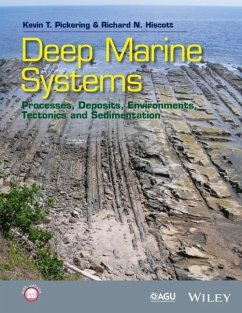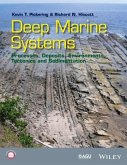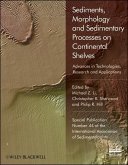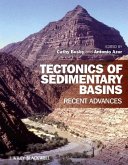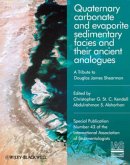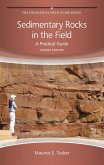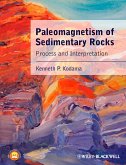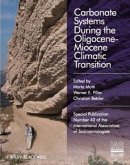Kevin T. Pickering, Richard N. Hiscott
Deep Marine Systems
Processes, Deposits, Environments, Tectonics and Sedimentation
Kevin T. Pickering, Richard N. Hiscott
Deep Marine Systems
Processes, Deposits, Environments, Tectonics and Sedimentation
- Broschiertes Buch
- Merkliste
- Auf die Merkliste
- Bewerten Bewerten
- Teilen
- Produkt teilen
- Produkterinnerung
- Produkterinnerung
Deep-water (below wave base) processes, although generally hidden from view, shape the sedimentary record of more than 65% of the Earth's surface, including large parts of ancient mountain belts. This book aims to inform advanced-level undergraduate and postgraduate students, and professional Earth scientists with interests in physical oceanography and hydrocarbon exploration and production, about many of the important physical aspects of deep-water (mainly deep-marine) systems. The authors consider transport and deposition in the deep sea, trace-fossil assemblages, and facies stacking…mehr
Andere Kunden interessierten sich auch für
![Deep Marine Systems Deep Marine Systems]() Kevin T. PickeringDeep Marine Systems151,99 €
Kevin T. PickeringDeep Marine Systems151,99 €![Sediments, Morphology and Sedimentary Processes on Continental Shelves Sediments, Morphology and Sedimentary Processes on Continental Shelves]() Sediments, Morphology and Sedimentary Processes on Continental Shelves177,99 €
Sediments, Morphology and Sedimentary Processes on Continental Shelves177,99 €![Tectonics of Sedimentary Basins Tectonics of Sedimentary Basins]() Tectonics of Sedimentary Basins176,99 €
Tectonics of Sedimentary Basins176,99 €![Quaternary Carbonate and Evaporite Sedimentary Facies and Their Ancient Analogues Quaternary Carbonate and Evaporite Sedimentary Facies and Their Ancient Analogues]() Quaternary Carbonate and Evaporite Sedimentary Facies and Their Ancient Analogues119,99 €
Quaternary Carbonate and Evaporite Sedimentary Facies and Their Ancient Analogues119,99 €![Sedimentary Rocks in the Field Sedimentary Rocks in the Field]() Maurice E. TuckerSedimentary Rocks in the Field71,99 €
Maurice E. TuckerSedimentary Rocks in the Field71,99 €![Paleomagnetism of Sedimentary Rocks Paleomagnetism of Sedimentary Rocks]() Kenneth P. KodamaPaleomagnetism of Sedimentary Rocks111,99 €
Kenneth P. KodamaPaleomagnetism of Sedimentary Rocks111,99 €![Carbonate Systems During the Olicocene-Miocene Climatic Transition Carbonate Systems During the Olicocene-Miocene Climatic Transition]() Carbonate Systems During the Olicocene-Miocene Climatic Transition131,99 €
Carbonate Systems During the Olicocene-Miocene Climatic Transition131,99 €-
-
-
Deep-water (below wave base) processes, although generally hidden from view, shape the sedimentary record of more than 65% of the Earth's surface, including large parts of ancient mountain belts. This book aims to inform advanced-level undergraduate and postgraduate students, and professional Earth scientists with interests in physical oceanography and hydrocarbon exploration and production, about many of the important physical aspects of deep-water (mainly deep-marine) systems. The authors consider transport and deposition in the deep sea, trace-fossil assemblages, and facies stacking patterns as an archive of the underlying controls on deposit architecture (e.g., seismicity, climate change, autocyclicity). Topics include modern and ancient deep-water sedimentary environments, tectonic settings, and how basinal and extra-basinal processes generate the typical characteristics of basin slopes, submarine canyons, contourite mounds and drifts, submarine fans, basin floors and abyssal plains.
Hinweis: Dieser Artikel kann nur an eine deutsche Lieferadresse ausgeliefert werden.
Hinweis: Dieser Artikel kann nur an eine deutsche Lieferadresse ausgeliefert werden.
Produktdetails
- Produktdetails
- Wiley Works
- Verlag: Wiley & Sons
- 1. Auflage
- Seitenzahl: 688
- Erscheinungstermin: 9. November 2015
- Englisch
- Abmessung: 279mm x 217mm x 35mm
- Gewicht: 1871g
- ISBN-13: 9781405125789
- ISBN-10: 1405125780
- Artikelnr.: 34760577
- Herstellerkennzeichnung
- Libri GmbH
- Europaallee 1
- 36244 Bad Hersfeld
- gpsr@libri.de
- Wiley Works
- Verlag: Wiley & Sons
- 1. Auflage
- Seitenzahl: 688
- Erscheinungstermin: 9. November 2015
- Englisch
- Abmessung: 279mm x 217mm x 35mm
- Gewicht: 1871g
- ISBN-13: 9781405125789
- ISBN-10: 1405125780
- Artikelnr.: 34760577
- Herstellerkennzeichnung
- Libri GmbH
- Europaallee 1
- 36244 Bad Hersfeld
- gpsr@libri.de
Kevin T. Pickering is Professor of Sedimentology & Stratigraphy in the Department of Earth Sciences at University College London, U.K. He has published ~140 peer-reviewed papers, co-authored 6 books and edited 3 books on aspects of deep-water sediments and global environmental issues. He managed the industry-sponsored Ainsa Project, an integrated outcrop-subsurface drilling project to understand deep-marine channels in the Spanish Pyrenees, and has sailed on four international scientific drilling expeditions (DSDP, ODP, IODP). In 2010, in recognition of his research, Pickering was elected as a Fellow of the Geological Society of America. Richard N. Hiscott is an Emeritus Professor at Memorial University of Newfoundland, Canada. His 40 years of process-oriented research covers ancient deep-sea to alluvial facies of Proterozoic to Cretaceous age, four Ocean Drilling Program campaigns including Amazon submarine fan, Quaternary sedimentology of the Labrador Sea, Santa Monica Basin, and the Black Sea region including dynamics of the saline gravity current that enters the low-salinity Black Sea through the Bosphorus Strait.
Preface xi About the companion website xiii Part 1 Process and product 1 1 Physical and biological processes 3 1.1 Introduction 4 1.2 Shelf-edge processes 5 1.3 Deep, thermohaline, clear-water currents 12 1.4 Density currents and sediment gravity flows 16 1.5 Turbidity currents and turbidites 23 1.6 Concentrated density flows and their deposits 42 1.7 Inflated sandflows and their deposits 45 1.8 Cohesive flows and their deposits 46 1.9 Accumulation of biogenic skeletons and organic matter 52 2 Sediments (facies) 59 2.1 Introduction 60 2.2 Facies classifications 60 2.3 Facies Class A: Gravels, muddy gravels, gravelly muds, pebbly sands,
5% gravel grade 65 >80% sand grade, <5% pebble grade 75 2.5 Facies Class C: Sand-mud couplets and muddy sands, 20-80% sand grade, <80% mud grade (mostly silt) 79 >80% mud,
40% silt, 0-20% sand 85 2.7 Facies Class E:
95% mud grade, <40% silt grade, <5% sand and coarser grade, <25% biogenics 90 2.8 Facies Class F: Chaotic deposits 98 >75% biogenics), muddy oozes (50-75% biogenics), biogenic muds (25-50% biogenics) and chemogenic sediments, <5% terrigenous sand and gravel 102 2.10 Injectites (clastic dykes and sills) (Figs 2.46-2.50) 105 2.11 Facies associations 111 3 Deep-water ichnology 112 3.1 Introduction 112 3.2 General principles of ichnology 113 3.3 Colonisation of SGF deposits: Opportunistic and equilibrium ecology 122 3.4 Ichnofacies 125 3.5 Ichnofabrics 127 3.6 Trace fossils in core 128 3.7 Case study I: Trace fossils as diagnostic indicators of deep-marine environments, Middle Eocene Ainsa-Jaca basins, Spanish Pyrenees 129 3.8 Case study II: Subsurface ichnological characterisation of the Middle Eocene Ainsa deep-marine system, Spanish Pyrenees 130 3.9 Summary of ichnology studies in deep-water systems 134 3.10 Concluding remarks 134 4 Time-space integration 136 4.1 Introduction 136 4.2 Submarine fan growth phases and sequence stratigraphy 144 4.3 Tectono-thermal/glacio-eustatic controls at evolving passive continental margins 153 4.4 Eustatic sea-level changes at active plate margins 154 4.5 Changing relative base level and sediment delivery processes 160 4.6 Autocyclic processes 164 4.7 Palaeo-seismicity and the stratigraphic record 171 4.8 Deconvolving tectonic and climatic controls on depositional sequences in tectonically active basins: Case study from the Eocene, Spanish Pyrenees 171 4.9 Problems in determining controls on sediment delivery 183 4.10 Carbonate versus siliciclastic systems 191 4.11 Computer simulations of deep-water stratigraphy 193 4.12 Laboratory simulations of deep-water stratigraphy 193 4.13 Supercritical versus subcritical fans 194 4.14 Hierarchical classification of depositional units 195 4.15 Concluding comments 196 5 Statistical properties of sediment gravity flow (SGF) deposits 200 5.1 Introduction 200 5.2 Cloridorme Formation, Middle Ordovician, Québec 205 5.3 Vertical trends 218 Part 2 Systems 237 6 Sediment drifts and abyssal sediment waves 239 6.1 Introduction 239 6.2 Distribution and character of contourites and sediment drifts, North Atlantic Ocean 241 6.3 Facies of muddy and sandy contourites 251 6.4 Seismic facies of contourites 255 6.5 The debate concerning bottom-current reworking of sandy fan sediments 255 6.6 Ancient contourites 257 6.7 Facies model for sediment drifts 260 7 Submarine fans and related depositional systems: modern 262 7.1 Introduction 262 7.2 Major controls on submarine fans 266 7.3 Submarine canyons 274 7.4 Architectural elements of submarine-fan systems 277 7.5 The distribution of architectural elements in modern submarine fans 303 7.6 Modern non-fan dispersal systems 303 7.7 Concluding remarks 307 8 Submarine fans and related depositional systems: ancient 309 8.1 Introduction 309 8.2 Ancient submarine canyons 311 8.3 Ancient submarine channels 313 8.4 Comparing modern and ancient channels 355 8.5 Ancient lobe, lobe-fringe, fan-fringe and distal basin-floor deposits 357 8.6 Seafloor topography and onlaps 369 8.7 Scours 377 8.8 Basin-floor sheet-like systems 382 8.9 Prodeltaic clastic ramps 387 8.10 Concluding remarks 393 Part 3 Plate tectonics and sedimentation 403 9 Evolving and mature extensional systems 405 9.1 Introduction 406 9.2 Models for lithospheric extension 408 9.3 Subsidence and deep-water facies of rifts and young passive margins 410 9.4 The post-breakup architecture of passive margins 413 9.5 Failed rift systems 428 9.6 Fragments of ancient passive margins 429 9.7 Concluding remarks 430 10 Subduction margins 433 10.1 Introduction 433 10.2 Modern subduction factories 435 10.3 Arc-arc collision zones 474 10.4 Forearc summary model 482 10.5 Marginal/backarc basins 483 10.6 Ancient convergent-margin systems 488 10.7 Forearc/backarc cycles 493 10.8 Concluding remarks 493 11 Foreland basins 497 11.1 Introduction 498 11.2 Modern foreland basins 499 11.3 Ancient deep-marine foreland basins 506 11.4 Concluding remarks 523 12 Strike-slip continental margin basins 528 12.1 Introduction 528 12.2 Kinematic models for strike-slip basins 529 12.3 Suspect terranes 529 12.4 Depositional models for strike-slip basins 532 12.5 Modern strike-slip mobile zones 537 12.6 Ancient deep-marine oblique-slip mobile zones 557 12.7 Concluding remarks 566 References 573 Index 647
5% gravel grade 65 >80% sand grade, <5% pebble grade 75 2.5 Facies Class C: Sand-mud couplets and muddy sands, 20-80% sand grade, <80% mud grade (mostly silt) 79 >80% mud,
40% silt, 0-20% sand 85 2.7 Facies Class E:
95% mud grade, <40% silt grade, <5% sand and coarser grade, <25% biogenics 90 2.8 Facies Class F: Chaotic deposits 98 >75% biogenics), muddy oozes (50-75% biogenics), biogenic muds (25-50% biogenics) and chemogenic sediments, <5% terrigenous sand and gravel 102 2.10 Injectites (clastic dykes and sills) (Figs 2.46-2.50) 105 2.11 Facies associations 111 3 Deep-water ichnology 112 3.1 Introduction 112 3.2 General principles of ichnology 113 3.3 Colonisation of SGF deposits: Opportunistic and equilibrium ecology 122 3.4 Ichnofacies 125 3.5 Ichnofabrics 127 3.6 Trace fossils in core 128 3.7 Case study I: Trace fossils as diagnostic indicators of deep-marine environments, Middle Eocene Ainsa-Jaca basins, Spanish Pyrenees 129 3.8 Case study II: Subsurface ichnological characterisation of the Middle Eocene Ainsa deep-marine system, Spanish Pyrenees 130 3.9 Summary of ichnology studies in deep-water systems 134 3.10 Concluding remarks 134 4 Time-space integration 136 4.1 Introduction 136 4.2 Submarine fan growth phases and sequence stratigraphy 144 4.3 Tectono-thermal/glacio-eustatic controls at evolving passive continental margins 153 4.4 Eustatic sea-level changes at active plate margins 154 4.5 Changing relative base level and sediment delivery processes 160 4.6 Autocyclic processes 164 4.7 Palaeo-seismicity and the stratigraphic record 171 4.8 Deconvolving tectonic and climatic controls on depositional sequences in tectonically active basins: Case study from the Eocene, Spanish Pyrenees 171 4.9 Problems in determining controls on sediment delivery 183 4.10 Carbonate versus siliciclastic systems 191 4.11 Computer simulations of deep-water stratigraphy 193 4.12 Laboratory simulations of deep-water stratigraphy 193 4.13 Supercritical versus subcritical fans 194 4.14 Hierarchical classification of depositional units 195 4.15 Concluding comments 196 5 Statistical properties of sediment gravity flow (SGF) deposits 200 5.1 Introduction 200 5.2 Cloridorme Formation, Middle Ordovician, Québec 205 5.3 Vertical trends 218 Part 2 Systems 237 6 Sediment drifts and abyssal sediment waves 239 6.1 Introduction 239 6.2 Distribution and character of contourites and sediment drifts, North Atlantic Ocean 241 6.3 Facies of muddy and sandy contourites 251 6.4 Seismic facies of contourites 255 6.5 The debate concerning bottom-current reworking of sandy fan sediments 255 6.6 Ancient contourites 257 6.7 Facies model for sediment drifts 260 7 Submarine fans and related depositional systems: modern 262 7.1 Introduction 262 7.2 Major controls on submarine fans 266 7.3 Submarine canyons 274 7.4 Architectural elements of submarine-fan systems 277 7.5 The distribution of architectural elements in modern submarine fans 303 7.6 Modern non-fan dispersal systems 303 7.7 Concluding remarks 307 8 Submarine fans and related depositional systems: ancient 309 8.1 Introduction 309 8.2 Ancient submarine canyons 311 8.3 Ancient submarine channels 313 8.4 Comparing modern and ancient channels 355 8.5 Ancient lobe, lobe-fringe, fan-fringe and distal basin-floor deposits 357 8.6 Seafloor topography and onlaps 369 8.7 Scours 377 8.8 Basin-floor sheet-like systems 382 8.9 Prodeltaic clastic ramps 387 8.10 Concluding remarks 393 Part 3 Plate tectonics and sedimentation 403 9 Evolving and mature extensional systems 405 9.1 Introduction 406 9.2 Models for lithospheric extension 408 9.3 Subsidence and deep-water facies of rifts and young passive margins 410 9.4 The post-breakup architecture of passive margins 413 9.5 Failed rift systems 428 9.6 Fragments of ancient passive margins 429 9.7 Concluding remarks 430 10 Subduction margins 433 10.1 Introduction 433 10.2 Modern subduction factories 435 10.3 Arc-arc collision zones 474 10.4 Forearc summary model 482 10.5 Marginal/backarc basins 483 10.6 Ancient convergent-margin systems 488 10.7 Forearc/backarc cycles 493 10.8 Concluding remarks 493 11 Foreland basins 497 11.1 Introduction 498 11.2 Modern foreland basins 499 11.3 Ancient deep-marine foreland basins 506 11.4 Concluding remarks 523 12 Strike-slip continental margin basins 528 12.1 Introduction 528 12.2 Kinematic models for strike-slip basins 529 12.3 Suspect terranes 529 12.4 Depositional models for strike-slip basins 532 12.5 Modern strike-slip mobile zones 537 12.6 Ancient deep-marine oblique-slip mobile zones 557 12.7 Concluding remarks 566 References 573 Index 647
Preface xi About the companion website xiii Part 1 Process and product 1 1 Physical and biological processes 3 1.1 Introduction 4 1.2 Shelf-edge processes 5 1.3 Deep, thermohaline, clear-water currents 12 1.4 Density currents and sediment gravity flows 16 1.5 Turbidity currents and turbidites 23 1.6 Concentrated density flows and their deposits 42 1.7 Inflated sandflows and their deposits 45 1.8 Cohesive flows and their deposits 46 1.9 Accumulation of biogenic skeletons and organic matter 52 2 Sediments (facies) 59 2.1 Introduction 60 2.2 Facies classifications 60 2.3 Facies Class A: Gravels, muddy gravels, gravelly muds, pebbly sands,
5% gravel grade 65 >80% sand grade, <5% pebble grade 75 2.5 Facies Class C: Sand-mud couplets and muddy sands, 20-80% sand grade, <80% mud grade (mostly silt) 79 >80% mud,
40% silt, 0-20% sand 85 2.7 Facies Class E:
95% mud grade, <40% silt grade, <5% sand and coarser grade, <25% biogenics 90 2.8 Facies Class F: Chaotic deposits 98 >75% biogenics), muddy oozes (50-75% biogenics), biogenic muds (25-50% biogenics) and chemogenic sediments, <5% terrigenous sand and gravel 102 2.10 Injectites (clastic dykes and sills) (Figs 2.46-2.50) 105 2.11 Facies associations 111 3 Deep-water ichnology 112 3.1 Introduction 112 3.2 General principles of ichnology 113 3.3 Colonisation of SGF deposits: Opportunistic and equilibrium ecology 122 3.4 Ichnofacies 125 3.5 Ichnofabrics 127 3.6 Trace fossils in core 128 3.7 Case study I: Trace fossils as diagnostic indicators of deep-marine environments, Middle Eocene Ainsa-Jaca basins, Spanish Pyrenees 129 3.8 Case study II: Subsurface ichnological characterisation of the Middle Eocene Ainsa deep-marine system, Spanish Pyrenees 130 3.9 Summary of ichnology studies in deep-water systems 134 3.10 Concluding remarks 134 4 Time-space integration 136 4.1 Introduction 136 4.2 Submarine fan growth phases and sequence stratigraphy 144 4.3 Tectono-thermal/glacio-eustatic controls at evolving passive continental margins 153 4.4 Eustatic sea-level changes at active plate margins 154 4.5 Changing relative base level and sediment delivery processes 160 4.6 Autocyclic processes 164 4.7 Palaeo-seismicity and the stratigraphic record 171 4.8 Deconvolving tectonic and climatic controls on depositional sequences in tectonically active basins: Case study from the Eocene, Spanish Pyrenees 171 4.9 Problems in determining controls on sediment delivery 183 4.10 Carbonate versus siliciclastic systems 191 4.11 Computer simulations of deep-water stratigraphy 193 4.12 Laboratory simulations of deep-water stratigraphy 193 4.13 Supercritical versus subcritical fans 194 4.14 Hierarchical classification of depositional units 195 4.15 Concluding comments 196 5 Statistical properties of sediment gravity flow (SGF) deposits 200 5.1 Introduction 200 5.2 Cloridorme Formation, Middle Ordovician, Québec 205 5.3 Vertical trends 218 Part 2 Systems 237 6 Sediment drifts and abyssal sediment waves 239 6.1 Introduction 239 6.2 Distribution and character of contourites and sediment drifts, North Atlantic Ocean 241 6.3 Facies of muddy and sandy contourites 251 6.4 Seismic facies of contourites 255 6.5 The debate concerning bottom-current reworking of sandy fan sediments 255 6.6 Ancient contourites 257 6.7 Facies model for sediment drifts 260 7 Submarine fans and related depositional systems: modern 262 7.1 Introduction 262 7.2 Major controls on submarine fans 266 7.3 Submarine canyons 274 7.4 Architectural elements of submarine-fan systems 277 7.5 The distribution of architectural elements in modern submarine fans 303 7.6 Modern non-fan dispersal systems 303 7.7 Concluding remarks 307 8 Submarine fans and related depositional systems: ancient 309 8.1 Introduction 309 8.2 Ancient submarine canyons 311 8.3 Ancient submarine channels 313 8.4 Comparing modern and ancient channels 355 8.5 Ancient lobe, lobe-fringe, fan-fringe and distal basin-floor deposits 357 8.6 Seafloor topography and onlaps 369 8.7 Scours 377 8.8 Basin-floor sheet-like systems 382 8.9 Prodeltaic clastic ramps 387 8.10 Concluding remarks 393 Part 3 Plate tectonics and sedimentation 403 9 Evolving and mature extensional systems 405 9.1 Introduction 406 9.2 Models for lithospheric extension 408 9.3 Subsidence and deep-water facies of rifts and young passive margins 410 9.4 The post-breakup architecture of passive margins 413 9.5 Failed rift systems 428 9.6 Fragments of ancient passive margins 429 9.7 Concluding remarks 430 10 Subduction margins 433 10.1 Introduction 433 10.2 Modern subduction factories 435 10.3 Arc-arc collision zones 474 10.4 Forearc summary model 482 10.5 Marginal/backarc basins 483 10.6 Ancient convergent-margin systems 488 10.7 Forearc/backarc cycles 493 10.8 Concluding remarks 493 11 Foreland basins 497 11.1 Introduction 498 11.2 Modern foreland basins 499 11.3 Ancient deep-marine foreland basins 506 11.4 Concluding remarks 523 12 Strike-slip continental margin basins 528 12.1 Introduction 528 12.2 Kinematic models for strike-slip basins 529 12.3 Suspect terranes 529 12.4 Depositional models for strike-slip basins 532 12.5 Modern strike-slip mobile zones 537 12.6 Ancient deep-marine oblique-slip mobile zones 557 12.7 Concluding remarks 566 References 573 Index 647
5% gravel grade 65 >80% sand grade, <5% pebble grade 75 2.5 Facies Class C: Sand-mud couplets and muddy sands, 20-80% sand grade, <80% mud grade (mostly silt) 79 >80% mud,
40% silt, 0-20% sand 85 2.7 Facies Class E:
95% mud grade, <40% silt grade, <5% sand and coarser grade, <25% biogenics 90 2.8 Facies Class F: Chaotic deposits 98 >75% biogenics), muddy oozes (50-75% biogenics), biogenic muds (25-50% biogenics) and chemogenic sediments, <5% terrigenous sand and gravel 102 2.10 Injectites (clastic dykes and sills) (Figs 2.46-2.50) 105 2.11 Facies associations 111 3 Deep-water ichnology 112 3.1 Introduction 112 3.2 General principles of ichnology 113 3.3 Colonisation of SGF deposits: Opportunistic and equilibrium ecology 122 3.4 Ichnofacies 125 3.5 Ichnofabrics 127 3.6 Trace fossils in core 128 3.7 Case study I: Trace fossils as diagnostic indicators of deep-marine environments, Middle Eocene Ainsa-Jaca basins, Spanish Pyrenees 129 3.8 Case study II: Subsurface ichnological characterisation of the Middle Eocene Ainsa deep-marine system, Spanish Pyrenees 130 3.9 Summary of ichnology studies in deep-water systems 134 3.10 Concluding remarks 134 4 Time-space integration 136 4.1 Introduction 136 4.2 Submarine fan growth phases and sequence stratigraphy 144 4.3 Tectono-thermal/glacio-eustatic controls at evolving passive continental margins 153 4.4 Eustatic sea-level changes at active plate margins 154 4.5 Changing relative base level and sediment delivery processes 160 4.6 Autocyclic processes 164 4.7 Palaeo-seismicity and the stratigraphic record 171 4.8 Deconvolving tectonic and climatic controls on depositional sequences in tectonically active basins: Case study from the Eocene, Spanish Pyrenees 171 4.9 Problems in determining controls on sediment delivery 183 4.10 Carbonate versus siliciclastic systems 191 4.11 Computer simulations of deep-water stratigraphy 193 4.12 Laboratory simulations of deep-water stratigraphy 193 4.13 Supercritical versus subcritical fans 194 4.14 Hierarchical classification of depositional units 195 4.15 Concluding comments 196 5 Statistical properties of sediment gravity flow (SGF) deposits 200 5.1 Introduction 200 5.2 Cloridorme Formation, Middle Ordovician, Québec 205 5.3 Vertical trends 218 Part 2 Systems 237 6 Sediment drifts and abyssal sediment waves 239 6.1 Introduction 239 6.2 Distribution and character of contourites and sediment drifts, North Atlantic Ocean 241 6.3 Facies of muddy and sandy contourites 251 6.4 Seismic facies of contourites 255 6.5 The debate concerning bottom-current reworking of sandy fan sediments 255 6.6 Ancient contourites 257 6.7 Facies model for sediment drifts 260 7 Submarine fans and related depositional systems: modern 262 7.1 Introduction 262 7.2 Major controls on submarine fans 266 7.3 Submarine canyons 274 7.4 Architectural elements of submarine-fan systems 277 7.5 The distribution of architectural elements in modern submarine fans 303 7.6 Modern non-fan dispersal systems 303 7.7 Concluding remarks 307 8 Submarine fans and related depositional systems: ancient 309 8.1 Introduction 309 8.2 Ancient submarine canyons 311 8.3 Ancient submarine channels 313 8.4 Comparing modern and ancient channels 355 8.5 Ancient lobe, lobe-fringe, fan-fringe and distal basin-floor deposits 357 8.6 Seafloor topography and onlaps 369 8.7 Scours 377 8.8 Basin-floor sheet-like systems 382 8.9 Prodeltaic clastic ramps 387 8.10 Concluding remarks 393 Part 3 Plate tectonics and sedimentation 403 9 Evolving and mature extensional systems 405 9.1 Introduction 406 9.2 Models for lithospheric extension 408 9.3 Subsidence and deep-water facies of rifts and young passive margins 410 9.4 The post-breakup architecture of passive margins 413 9.5 Failed rift systems 428 9.6 Fragments of ancient passive margins 429 9.7 Concluding remarks 430 10 Subduction margins 433 10.1 Introduction 433 10.2 Modern subduction factories 435 10.3 Arc-arc collision zones 474 10.4 Forearc summary model 482 10.5 Marginal/backarc basins 483 10.6 Ancient convergent-margin systems 488 10.7 Forearc/backarc cycles 493 10.8 Concluding remarks 493 11 Foreland basins 497 11.1 Introduction 498 11.2 Modern foreland basins 499 11.3 Ancient deep-marine foreland basins 506 11.4 Concluding remarks 523 12 Strike-slip continental margin basins 528 12.1 Introduction 528 12.2 Kinematic models for strike-slip basins 529 12.3 Suspect terranes 529 12.4 Depositional models for strike-slip basins 532 12.5 Modern strike-slip mobile zones 537 12.6 Ancient deep-marine oblique-slip mobile zones 557 12.7 Concluding remarks 566 References 573 Index 647

